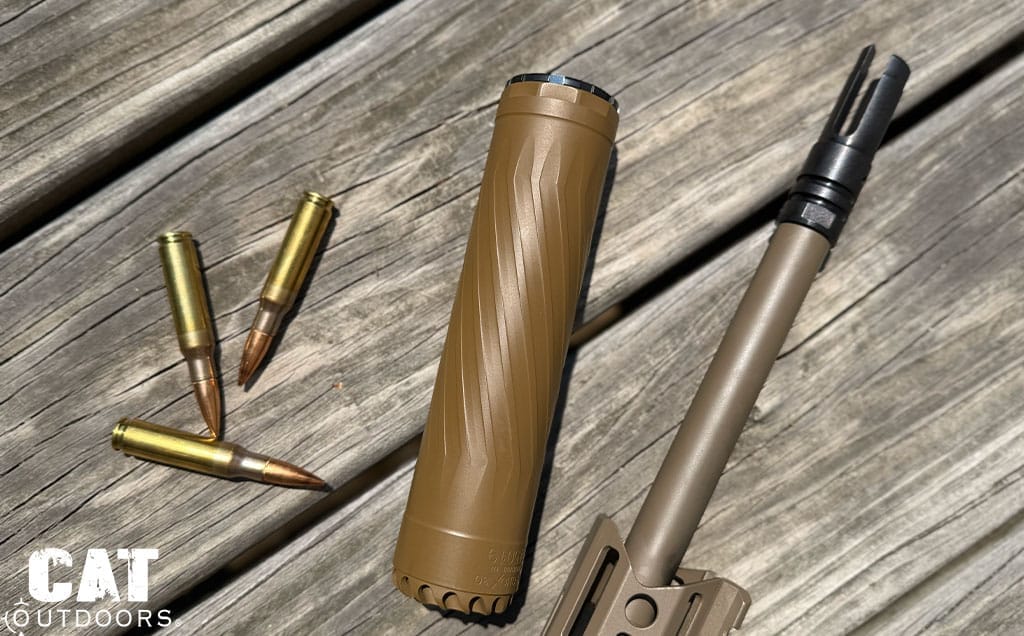11 Best AR-15 Suppressors 2025 (5.56 and Multi-Cal)
Ready to throw your first can on an AR? Want to trade that bang-bang for something a little more pew-pew?
Whether you’re looking to quiet the bark of your 5.56, tame recoil, or just avoid the side-eye at the range, a good AR-15 suppressor can completely change how your rifle performs and how you enjoy shooting it.
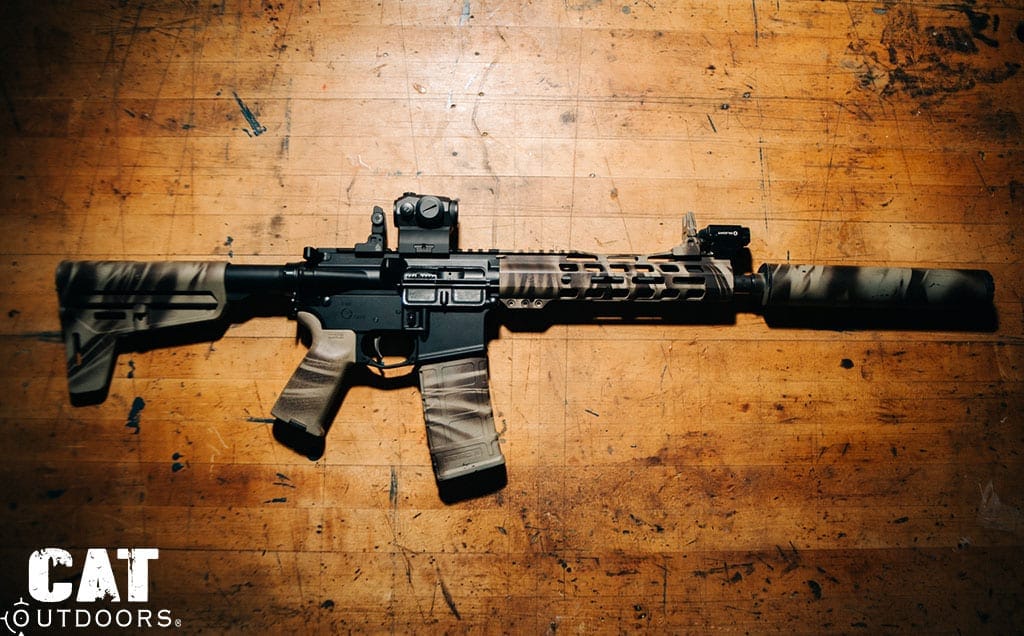
Suppressors (aka silencers if you’re feeling cinematic) aren’t just for the movies. They reduce sound, cut down on flash, and help you stay on target during rapid fire. Some even reduce gas blowback and felt recoil.
But finding the right one can be tricky.
You’ve got direct-thread cans, quick-detach mounts, full-auto rated options, lightweight titanium builds, multi-caliber models – the list goes on. Prices range from budget-friendly to full Gucci, and every suppressor has its pros and quirks.
So, what are the best AR-15 suppressors? What’s the quietest? Lightest? Most durable? And what if you’re new to suppressors entirely?
We tested the top options across categories, from duty-grade warhorses to range-day favorites, and broke it all down right here.
By the end of this guide, you’ll know which suppressor deserves a spot on your barrel, and which ones to avoid like a hot baffle strike.
Let’s make that bark a purr…
1. BEST OVERALL AR-15 SUPPRESSOR: SureFire SOCOM RC2
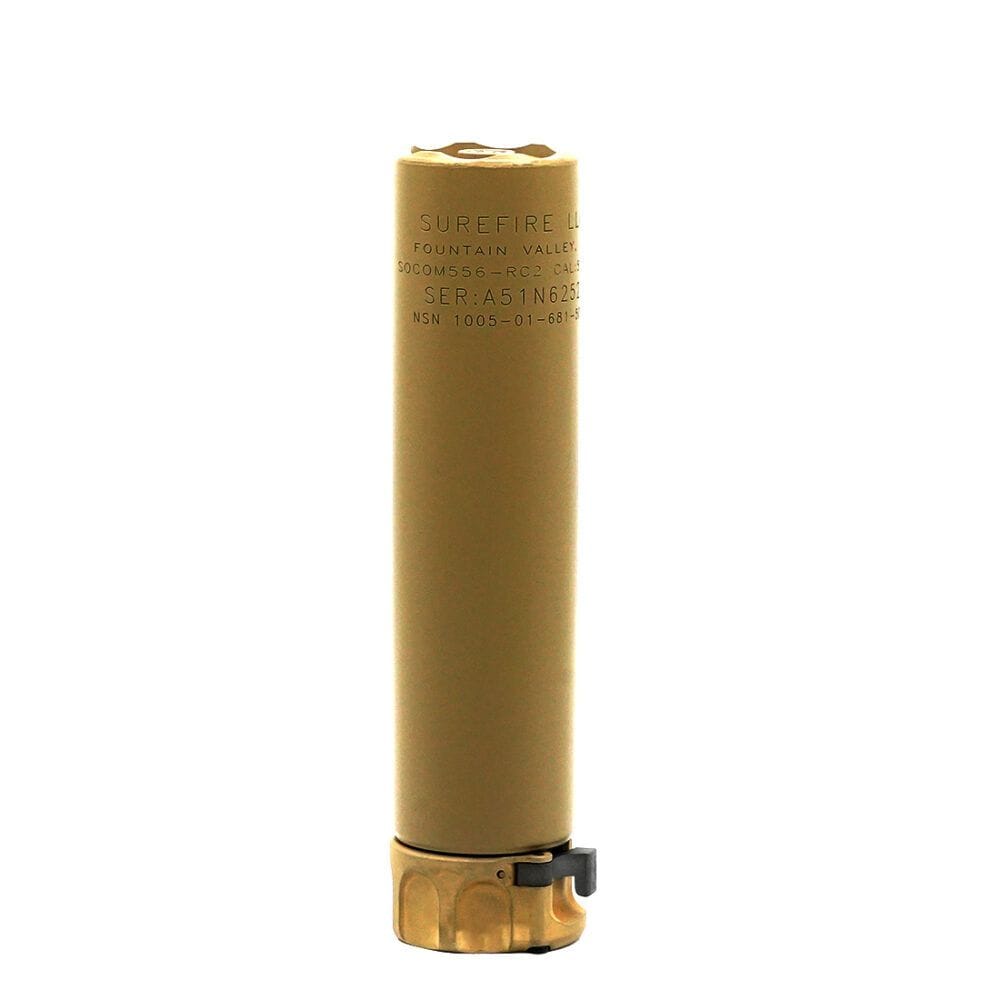
SureFire SOCOM RC2
Bereli (See Price)
Brownells (See Price)
AR-15 Discounts (See Price)
Euro Optic (See Price)
BattleHawk Armory (See Price)
The SOCOM RC2 is the one can everyone else has to stack up against. Born out of USSOCOM’s suppressor trials and still riding shotgun on M4A1s and Mk18s around the globe, it isn’t the lightest, shortest, or even quietest option on the rack, but it is the suppressor that’s gone to war more than any other 5.56 can in production.
If you want a muzzle device that shrugs off full-auto abuse, comes off without tools, and keeps your rifle running when everything around you is trying to break, the RC2 sets the gold standard.

What We Like: Durability is the headline feature. SureFire builds the RC2 from Inconel and stainless, then laser-welds the stack so nothing rattles loose after a few mag dumps. That construction lets it shrug off sustained full-auto fire and high-temp cycles that melt lesser cans.
The proprietary Fast-Attach system locks up with a quick twist and stays locked, so zero tools, no carbon-frozen threads, and no wandering point of impact once it’s torqued.
It’s also one of the few cans that’s been comprehensively tested against over-pressure events, over-the-beach dunk tests, and drop tests the way SOCOM requires. We’ve seen RC2s come off Mk18s glowing orange, cool down, and go right back on without a hiccup. If you’re running a short-barrel blaster, or planning on pounding out carbine classes, knowing your suppressor won’t gas-cut itself to pieces is worth the weight penalty.

Back-pressure is surprisingly manageable for a “traditional” baffle design. On a 16-inch rifle the gas signature feels comparable to many newer low-pressure cans, and on 10.3-inch setups you can keep the charging handle out of your teeth without a gas-buster.
Sound reduction hovers in the mid-130 dB range with full-power 5.56. Audibly louder than some newer flow-through designs, but still firmly hearing-safe with ear-pro on and noticeably more comfortable than bare muzzle blast.
Flaws but Not Dealbreakers: At just over 17 ounces and six inches long, the RC2 adds more weight and length than the whiz-bang titanium options. You’re also locked into SureFire’s muzzle devices for mounting – great if you like their Warcomp or SOCOM brake, less great if you want to mix brands.
Street price rarely dips below $1,400, and demand spikes can push it higher.
Finally, if absolute “Hollywood quiet” is the goal, other cans shave off another decibel or two, though none of them can point to the same service record.
Bottom Line: Calling the SOCOM RC2 “overbuilt” isn’t a knock, it’s the entire selling point. If your AR is a range toy, you might lean toward a lighter, quieter, or cheaper can. If you want the suppressor that’s been vetted by the guys who roll out of helicopters for a living, and you’d rather spend once, trust it forever – the RC2 is still the benchmark.
2. BEST MULTI-CALIBER SUPPRESSOR: Banish 30 V2
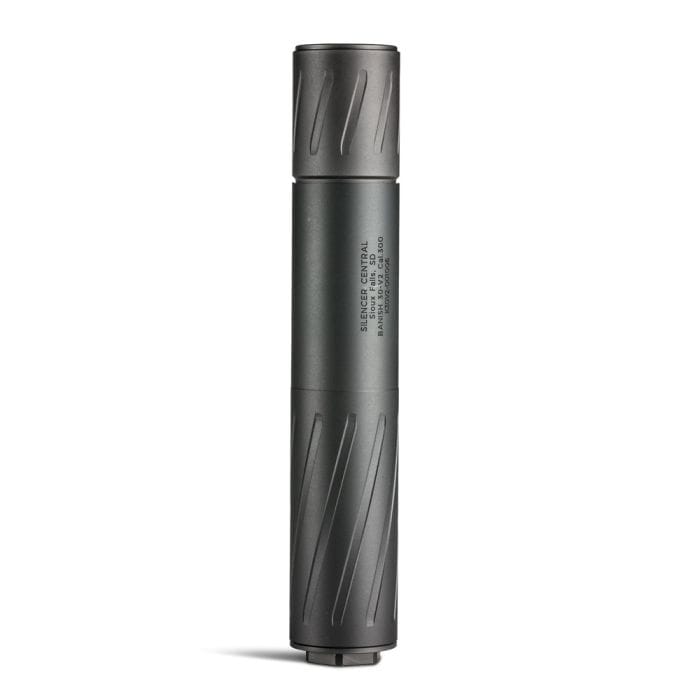
Banish 30 V2
The original Banish 30 was one of the most popular suppressors in America, and this new V2 model is shorter, lighter, and quieter than its predecessor.
Designed as an all-titanium, user-serviceable suppressor, the Banish 30 V2 brings impressive sound reduction to your AR-15 (and many other rifles) without adding undue weight or complexity. Even better, Silencer Central made these upgrades without a price hike – the V2 still comes in around a $999 MSRP.
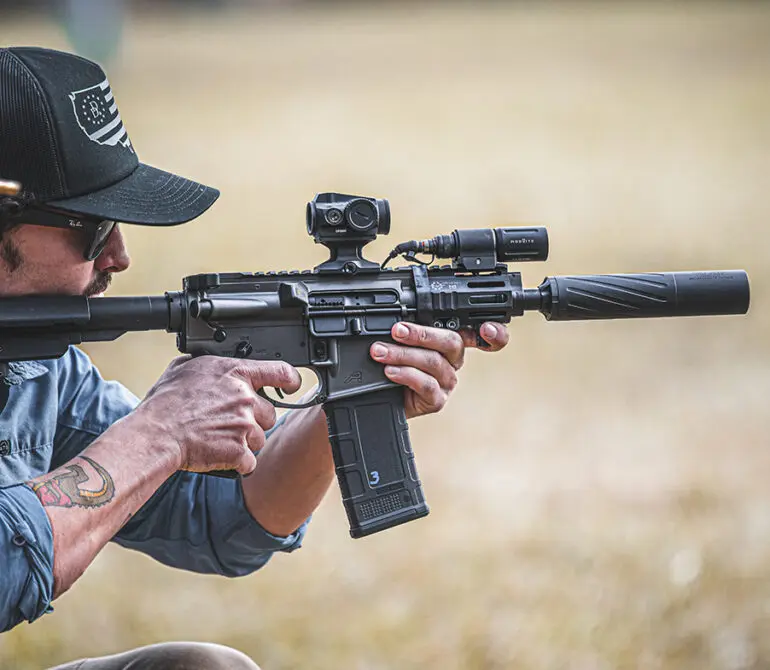
What We Like: The Banish 30 V2 can safely handle anything you’d run on an AR-15 – from 5.56 NATO and .223 Rem, to .300 BLK, 6.5 Grendel, and even larger calibers on other platforms. It’s truly a one-suppressor solution for a wide range of firearms.
This suppressor lives up to its name by banishing a lot of the boom. In testing, it knocked about 34.5 dB off the muzzle report of a .308 rifle.
On a 5.56 AR-15, that means the Banish 30 V2 can take the edge off the sharp crack and bring the noise down to much safer levels (well within hearing-safe territory for most loads). No suppressor can completely silence supersonic 5.56, but this one significantly reduces blast and concussion, making your AR much more comfortable to shoot.
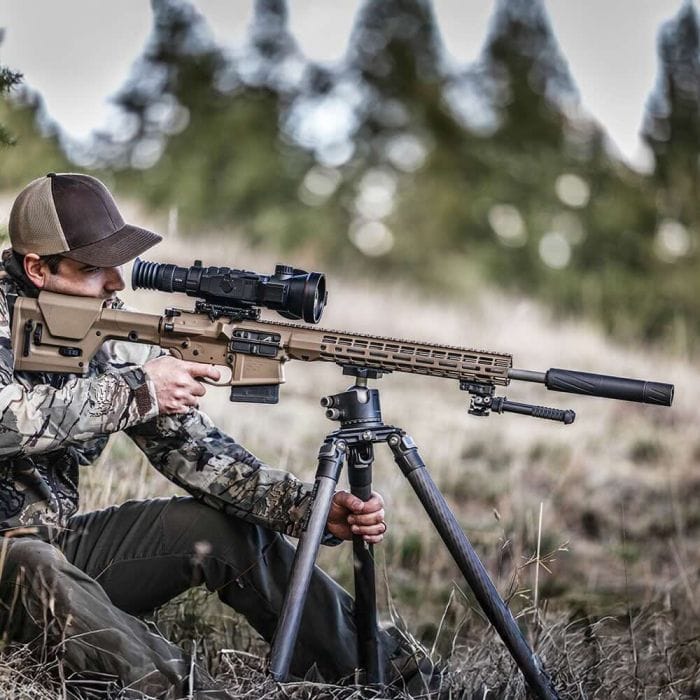
Like the original, the V2 is modular. You can run it in two configurations: a full-length 8.17-inch setup with all 11 baffles for maximum suppression, or a shorter 6.4-inch setup (8 baffles) for a handier package.
In the long config it’s quieter; in the short config it’s more compact – you choose based on your mission. Switching configurations is as simple as removing or adding a threaded baffle segment. This flexibility is great for AR-15 shooters who might want a shorter suppressor on a carbine for home defense or drills, and the full-length when sound reduction is the top priority.
The Banish 30 V2 is surprisingly light for its size. It weighs just 12.4 oz in full configuration, or a mere 9.5 oz in the short setup. For context, many .30 caliber suppressors weigh 15–20 ounces or more.
That means even on a lightweight AR-15, the Banish 30 V2 won’t make your rifle feel like a boat anchor. The balance remains good, and you can maneuver easily whether you’re shooting off-hand or trekking in the field.

The suppressor’s rear end is compatible with a wide array of mounting options. It ships with a 5/8×24 direct-thread adapter (for .30 cal barrels) and you can easily swap in other thread adapters or quick-detach mounts to fit your needs. AR-15 shooters will love this, because you can use common QD systems now.
Unlike many centerfire suppressors, the Banish 30 V2 can be fully disassembled for cleaning. After a hard day of shooting (especially with dirty ammo like rimfire or subsonic .300 BLK), you can unscrew the tube and slide out the baffle stack to scrub away carbon and lead buildup. This is a huge plus for maintaining performance and longevity – you’re not stuck with a gunked-up can forever.
Flaws but Not Dealbreakers: It’s still a traditional baffle can, so an AR will push a bit more gas into your face than with a true flow-through design. An adjustable gas block or heavier buffer fixes that fast, but it’s worth noting.
Another drawback is that it will handle occasional bursts or rapid fire, but as a lightweight can it’s not intended for prolonged cyclic abuse – a reasonable trade-off for an AR suppressor that’s otherwise ideal in almost every way
Finally, a dedicated 5.56-only suppressor can squeak out a few extra decibels of reduction, yet you give up the Banish’s “one-can-does-all” superpower to get it.
Bottom Line: If your safe holds more than one caliber—and whose doesn’t—the Banish 30 V2 is the smartest single purchase you can bolt onto an AR-15 in 2025. It’s quiet, absurdly light, effortlessly modular, and just as happy riding a precision bolt gun as it is living on a dirty training carbine. One tax stamp, one lifetime warranty, and every rifle you own suddenly sounds better.
3. EDITOR’S PICK: Anechoic AnechoX 30 w/ Flow Cap
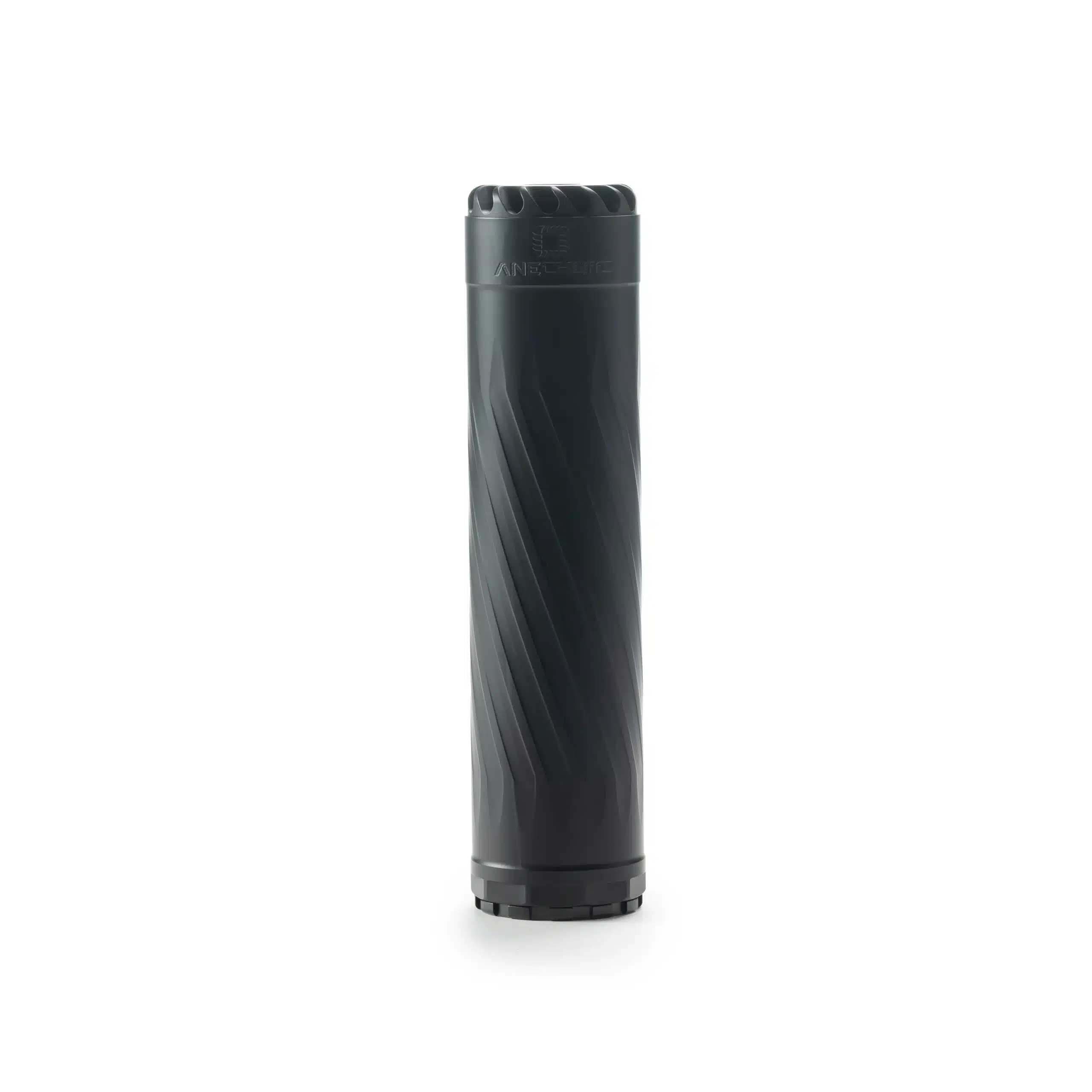
Anechoic AnechoX 30
The AnechoX 30 combines a low-backpressure, “flow-through” gas system with full user serviceability and multi-caliber versatility, a rare trifecta not found in other cans. For the shooter, that means you get outstanding sound reduction without the usual clouds of gas to the face, all while keeping your rifle quick-handling and balanced.
Add to that, the can is compact and built from Grade 5 titanium, it feels practically weightless.
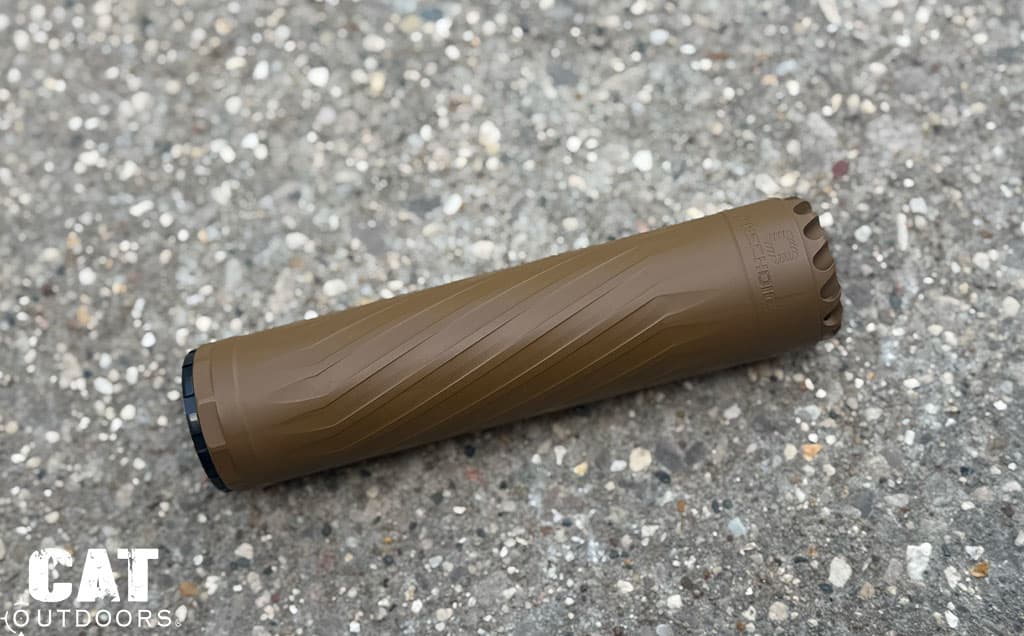
What We Like: The AnechoX 30 knocks the sharp crack of 5.56 down to a dull thump – not Hollywood quiet, but more than hearing-safe enough to hold a normal conversation next to a suppressed rifle.
What’s most impressive is how clean the shooting experience feels. The Flow Cap’s angled vents give propellant an exit up front, so you’re not choking on fumes or getting stung by gas with every shot.
The design essentially lets your rifle breathe, making suppressed fire far more comfortable during drills or extended range time.
It uses a series of nested “X” baffles that disrupt and reroute propellant gases before they can hammer you or the rifle’s action. Each titanium baffle has tiny serrations and ports (an idea borrowed from flash hider designs) that strip and slow the gas, maximizing sound reduction and even smoothing out recoil impulse.

The exterior is nicely machined and finished in high-temp Cerakote, and the AnechoX 30 uses a universal HUB mounting interface. In practice, that means it ships with a direct-thread adapter but can mount on almost any common quick-attach system or muzzle device you prefer, giving AR owners plenty of flexibility.
We also appreciate that Anechoic made this suppressor fully user-serviceable. You can crack it open (the front cap uses a clever left-hand thread) and pull the entire baffle stack for cleaning or inspection, which is a huge plus for maintenance and longevity.
Finally, it breaks down without drama: left-hand thread the cap, slide the titanium baffle stack out, scrub, re-stack, shoot. Few rifle cans let you do that, and none this light.
Flaws but Not Dealbreakers: Titanium’s great until it glows. Anechoic rates the can for full-auto, but after a mag dump you’ll want to give it a breather; cook it cherry-red and you’ll shorten its life fast.
It also isn’t the absolute quietest meter reading in the class. Larger, heavier tubs still win on raw decibels, but for a can this small the number is impressive.
Lastly, the price lands north of many steel competitors. You’re paying for weight savings, user serviceability, and that flow-through geometry.
Bottom Line: If you want a suppressor that keeps your AR light, quiet, and mercifully free of back-pressure without locking you into a proprietary mount, the AnechoX 30 is tough to top. It’s the can we grab when we plan to run suppressed all day, not just for a demonstration string.
4. QUIETEST 5.56 SUPPRESSOR: PRT Vent 3
The PTR Vent 3 is a relatively new entrant in the suppressor market, promising cutting-edge tech to deliver exceptional quietness for 5.56 rifles. PTR (better known for their G3-pattern rifles) poured innovation into this can – and it shows.

What We Like: The Vent 3 delivers astoundingly low sound readings for a 5.56 suppressor. After a slight first-round pop the Vent 3’s muzzle report hovers ~130 dB, which is truly impressive.
The Vent 3 owes its hush largely to PTR’s Purposely Induced Porosity (PIP) technology. Essentially, the suppressor’s internals are 3D-printed in titanium with a porous, foam-like lattice structure that lets gas permeate and cool throughout the entire baffle stack. This maximizes surface area for heat dissipation and turbulence, knocking down the sound signature dramatically.

In less geeky terms: PTR found a way to cram a lot of gas-trapping volume into a compact package by using a titanium sponge inside the can. The result is not just lower decibels, but a softer, deeper sound that you will no doubt find more pleasant.
Unusually for an ultra-quiet can, the Vent 3 is also designed for reduced backpressure. PTR specifically engineered it to vent gas in stages and through that porous medium, so it doesn’t send as much pressure back into your rifle’s action. The benefits are tangible: less gas blowback in your face, less sooty buildup in the action, and even a bit gentler recoil impulse.
Thanks to a full titanium, monolithic 3D-printed construction, it weighs only about 11.8 oz in a full-size (7.8-inch) package. For comparison, many competing suppressors of similar length in steel or Inconel are 16–20+ ounces.
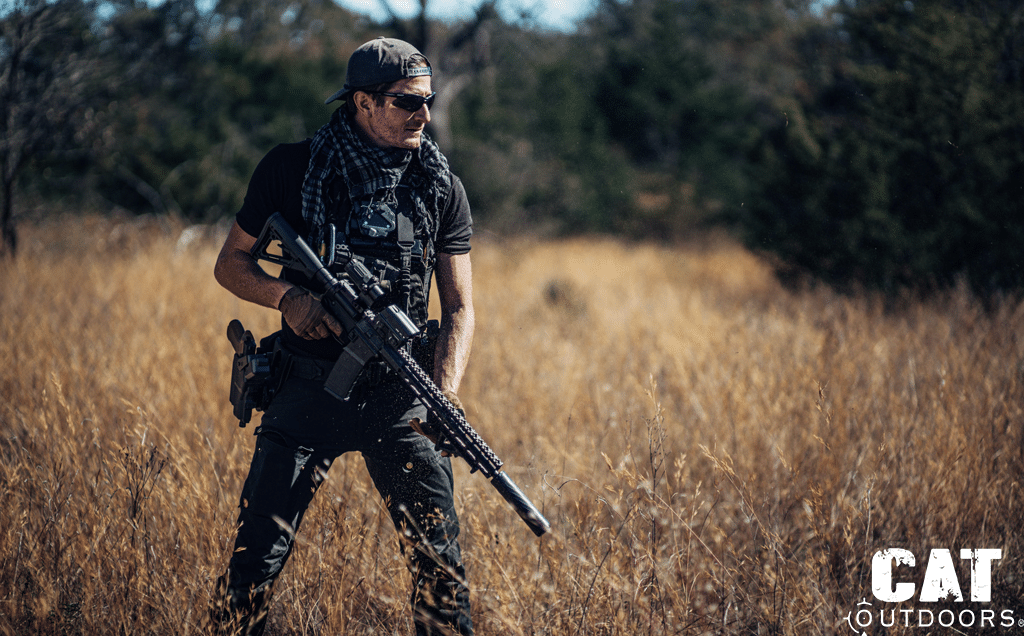
More from CAT Outdoors:
Best AR-15s
Best AR-15 Triggers
Best AR Red Dots
Best AR-15 Charging Handles
The one-piece printed core and outer tube also mean no welds and excellent strength. It’s full-auto rated (with some limitations) and built to handle the abuse of 5.56 firing schedules.
PTR applied proprietary internal/external coatings to the Vent series for added carbon resistance and heat endurance. The exterior has an interesting dimpled texture – not just for looks, it actually reflects the internal lattice and likely aids in cooling.
Flaws but Not Dealbreakers: The Vent 3 typically retails around $1,300–$1,500, firmly in the high end of 5.56 suppressors. That’s hundreds more than many solid mid-tier options. Even competing “quietest 5.56” contenders are often a bit less expensive. For example, the Radical Defense LS5 (another super-quiet, low-blowback 5.56 can) is roughly in the $900–$1000 range in steel form.
Is the ~2-3 dB noise improvement worth an extra few hundred dollars? For the average shooter, maybe not. Diminishing returns do kick in at this level of suppression. But for those chasing the quietest setup, the cost may be justified.
While lightweight for its length, the Vent 3 is still a full-size suppressor. At ~7.8 inches long and 1.6 inches in diameter, it will add noticeable length to your rifle. It’s not a stumpy “K-can” by any means. In fact, it’s about 2 inches longer than a SureFire SOCOM RC2 or other typical 5.56 suppressors.

PTR mandates a minimum barrel length of 10.3″ for use, which rules out using the Vent 3 on 7″ or 8″ barreled ultra-compact builds.
The very first trigger pull might have a sharper crack, on the order of ~2–3 dB louder than the following shots. It is more noticeable on a shorter barreled AR. After that, the can’s internals stay gas-saturated and the sound reduction improves.
The Vent 3 is full-auto rated, but with a caveat – PTR recommends no more than ~120 rounds of continuous fire before letting it cool for 10 minutes. In other words, it’s fine with mag-dumps and burst firing to a point, but it’s not a belt-feed or unlimited full-auto can.
Lastly, the Vent 3’s porous internals raise some maintenance questions. Because gas (and carbon soot) diffuse through the foam-like baffles, there’s a concern that heavy use without cleaning could clog the tiny vent pathways over time.
How big a problem is this? It’s hard to say yet. The Vent 3 is not user-serviceable (like most rifle suppressors), so you can’t take it apart to scrape out carbon. The likely cleaning method would be to soak it in a solvent bath or use an ultrasonic cleaner periodically.
Bottom Line: The PTR Vent 3 delivers on its bold promise – it really is one of the quietest 5.56 suppressors you can buy. It has a remarkably low sound level with a pleasing deep tone. It achieves suppression on 5.56 that was basically unheard of a few years ago, on the order of ~130 dB at the muzzle, which brings the AR-15’s thunder crack down to a much more tolerable thump.
5. BEST FOR SHORT-BARREL ARs: HUXWRX Flow 556k
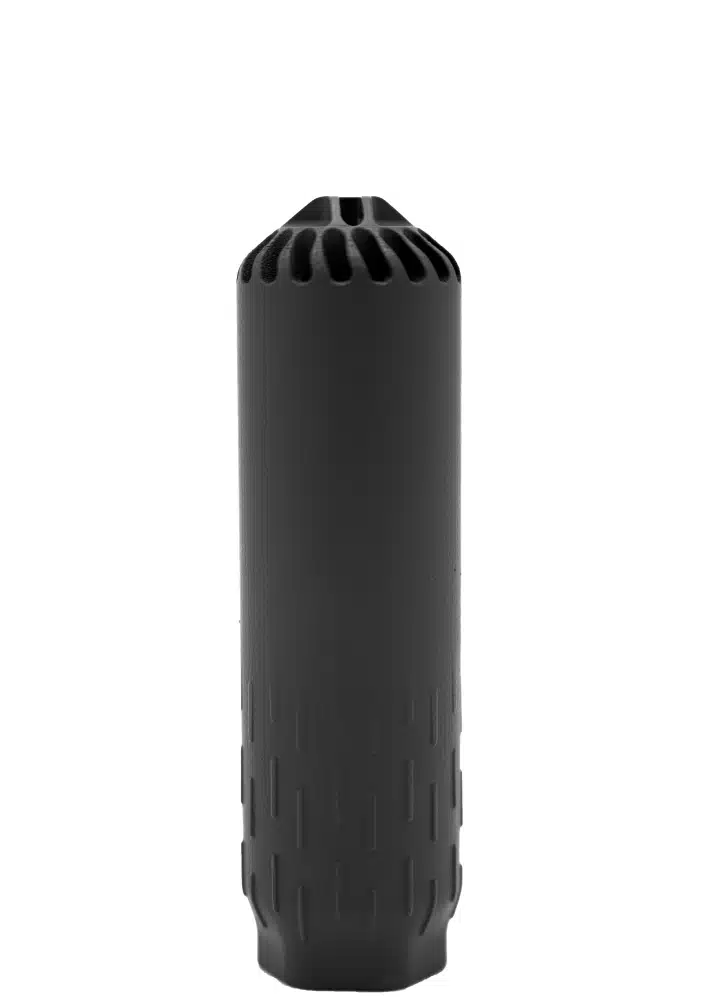
HUXWRX Flow 556k
Guns.com (See Price)
AR15 Discounts (See Price)
Bereli (See Price)
Scheels (See Price)
For SBR fans the biggest complaint about most cans isn’t weight or length, it’s the face-full of gas every time the bolt cycles. HUXWRX designed the Flow 556k specifically for short-barrel rifles, and it fixes that problem in a way no conventional baffle stack can match.
At barely 5.5 inches long and a hair over twelve ounces, it keeps an AR pistol or Mk18‐length carbine nimble, but the real magic is the Flow-Through core that vents gas forward instead of back into your eyes. If your idea of a range day is rapid strings from a 10.3″ blaster, this is the can that lets you breathe – and still talk to your buddies – between mags.
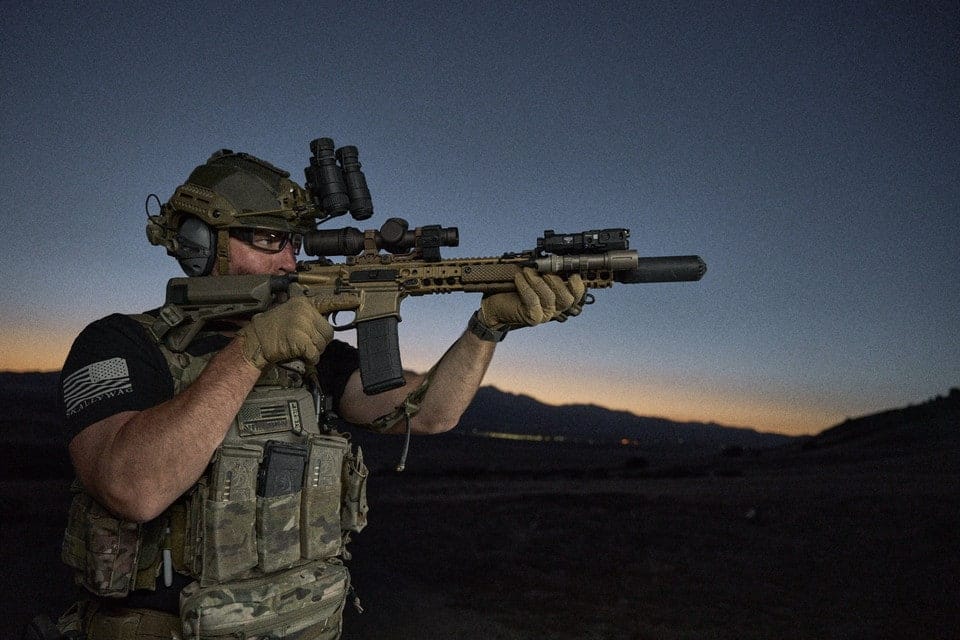
What We Like: We love how it virtually eliminates the gas blowback that usually plagues suppressed SBRs. Even on 10.3” and 11.5” uppers, the Flow 556k doesn’t choke you with gas or jack up your rifle’s cyclic rate.
Its patented Flow-Through design vents hot gases forward out of the suppressor, instead of back into your action. You don’t need special gas plugs or heavy buffers just to shoot your short AR comfortably suppressed.

Despite its compact size, the Flow 556k also delivers impressive sound suppression for the shooter. On a 10.3” Mk18 (one of the gassiest, loudest AR platforms), it was the first 5.56 can to ever achieve a 30+ suppression rating at the shooter’s ear in Pew Science’s tests.
No 5.56 suppressor will make a short barrel “Hollywood quiet,” but the Flow 556k significantly reduces the blast and concussion where it matters most (at your ear). At the same time, it also reduces muzzle flash – the built-in GeoFlash end cap tamps down the fireball that short barrels are notorious for.
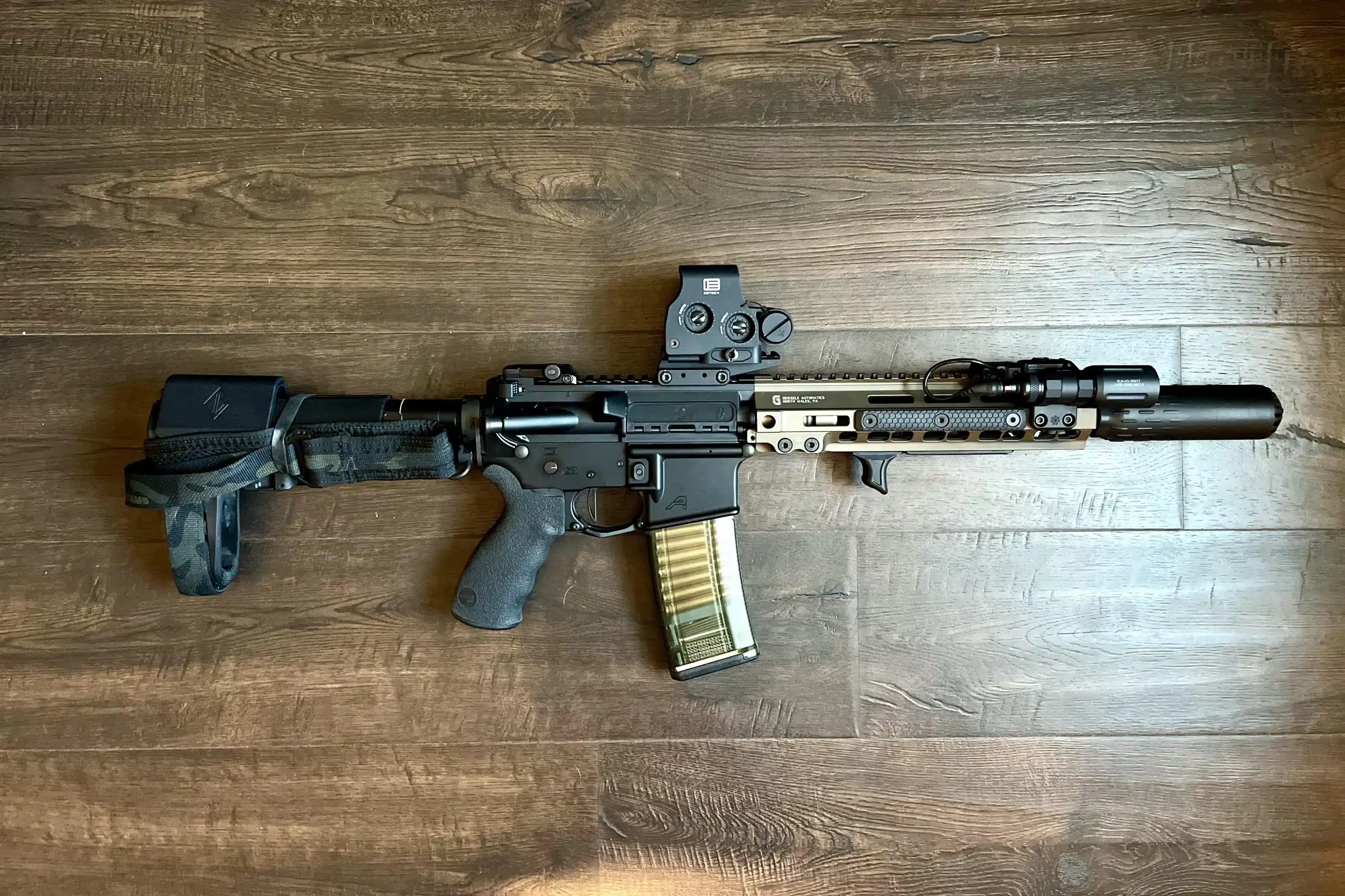
You’re effectively adding only about 5″ to your barrel, so even an 11.5″ gun stays very handy. The Flow 556k’s lightweight 3D-printed stainless construction keeps the weight at the muzzle down, which we appreciated when swinging the rifle in close-quarters drills.
HUXWRX lists no minimum barrel length restrictions for the Flow 556k, unlike some other cans on this list.
In short, the Flow 556k checks every box for an SBR suppressor: less gas, less flash, solid sound reduction, and combat-proven ruggedness.
Flaws but Not Dealbreakers: The Flow 556k’s flow-through design does come with a few trade-offs, though none are dealbreakers for us. First, it isn’t the absolute quietest suppressor in existence – at the muzzle, it’s a bit louder than some larger traditional baffle cans like the SureFire SOCOM RC2.
Heat buildup is another factor to consider. Because the Flow 556k is so compact and lightweight, it heats up quickly during rapid fire and holds heat longer than heavier cans.
After a few mag dumps on a 10″ gun, you’ll definitely want a glove or a heat cover, but honestly that’s true of most rifle suppressors, and the benefits here are worth it. Lastly, HUXWRX recommends periodic cleaning (around every 2,000–2,500 rounds) to clear out carbon from the Flow-Through baffle-less internals.
Unlike many sealed suppressors that you can ignore until thousands of rounds, this one performs best if you give it the occasional solvent soak and blast-out. It’s an extra maintenance step, but it’s easy to do and ensures the Flow 556k keeps running at peak performance.
Bottom Line: For AR-15s with short barrels (10″–12″), the HUXWRX Flow 556k is hands-down our top suppressor pick. It tames the SBR’s notoriously harsh blast and backpressure better than anything else out there, making a suppressed shorty far more pleasant and reliable to shoot. You get meaningful sound attenuation and flash reduction without turning your compact carbine into a long, front-heavy spear.
6. BEST VALUE MODULAR SUPPRESSOR: Aero Precision LAHAR-30
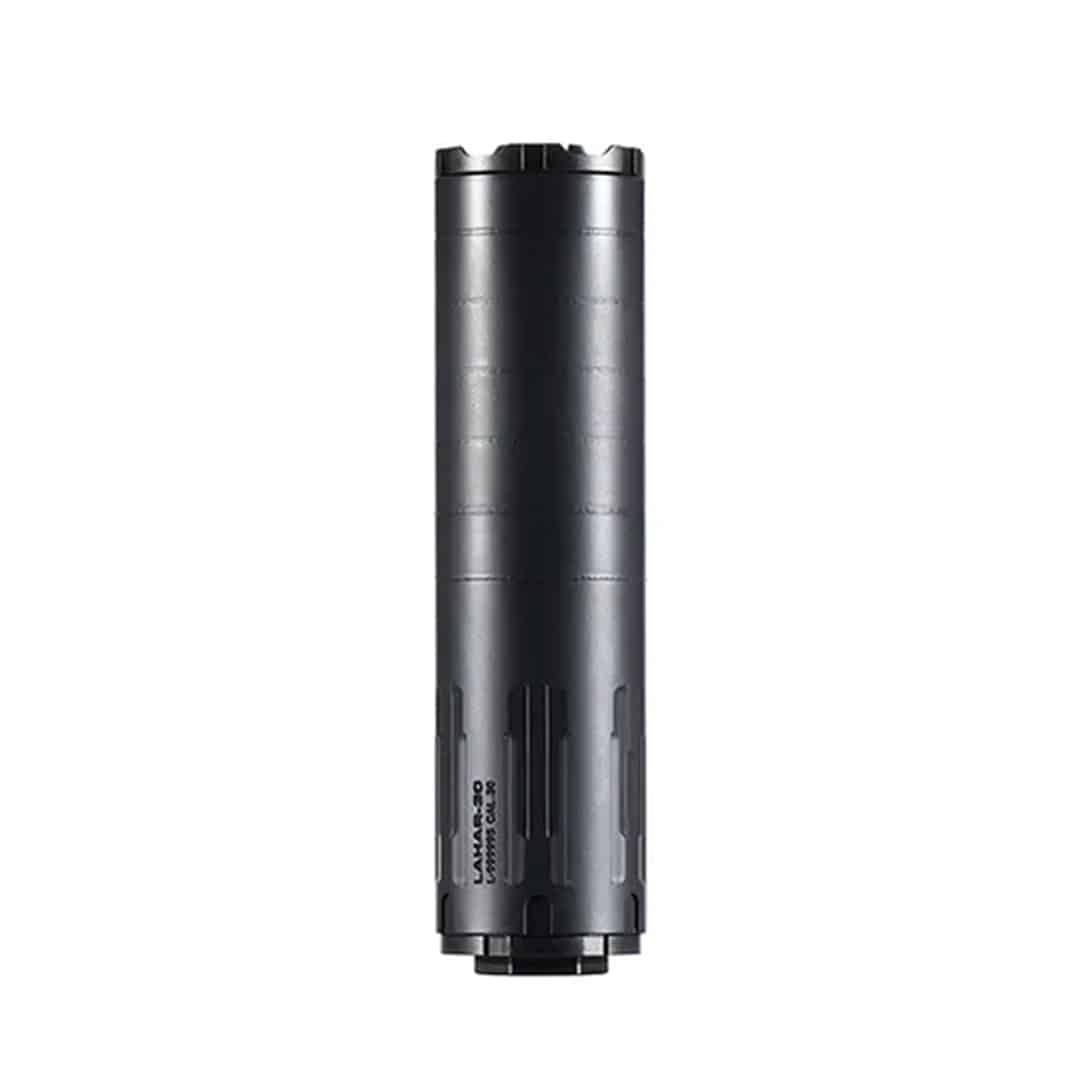
Aero Precision LAHAR-30
AR-15 Discounts (See Price)
BattleHawk Armory (See Price)
GrabAGun (See Price)
KyGunCo (See Price)
Brownells (See Price)
The Aero Precision Lahar-30 suppressor series has quickly earned a reputation as a do-it-all, best-value option for AR-15 enthusiasts. These .30-caliber suppressors (in both the full-size Lahar-30 and shorter Lahar-30K configurations) deliver durability and performance usually found in pricier cans.
Designed as multi-caliber workhorses, they handle everything from 5.56 NATO up to .300 Win Mag, making them extremely versatile for AR-15 users who may also run .300 BLK or .308.

What We Like: The Lahar-30 delivers sound reduction on par with or better than many higher-priced suppressors. In independent testing on a short-barreled 5.56 rifle (MK18), it actually outperformed most other .30-caliber cans, beating well-known models like the Dead Air Nomad-30 and even the Sandman-S in overall suppression.
On a 10.5″ AR-15, the Lahar’s noise level is comparable to dedicated 5.56 suppressors, but with a deeper tone and noticeably less gas blowback to the face.
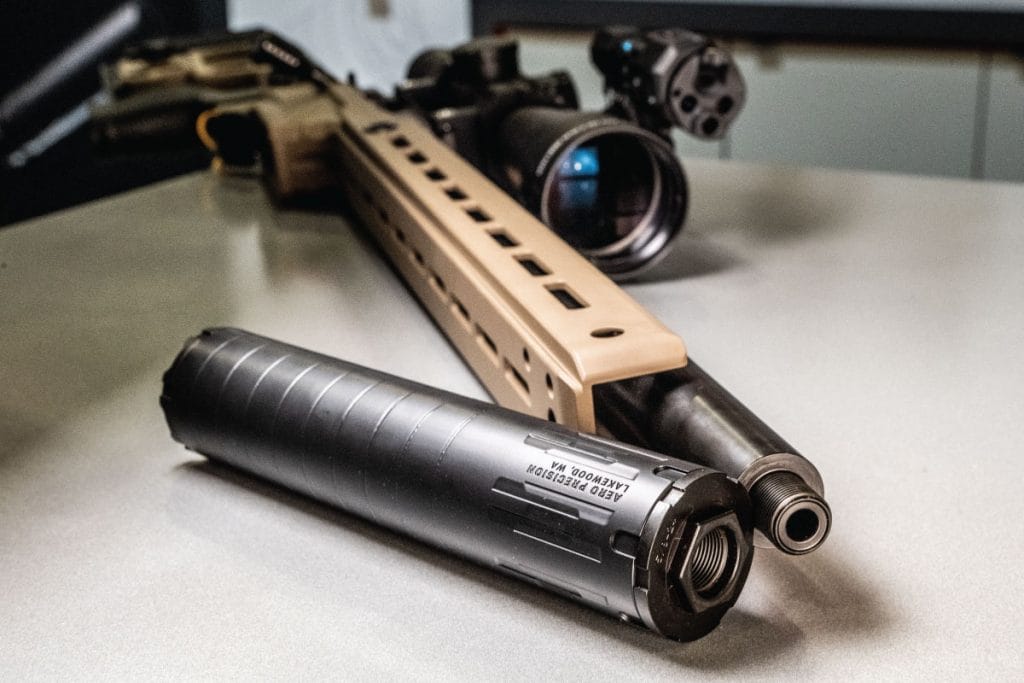
It uses fully welded 17-4 stainless steel construction with an Inconel blast baffle, so heat and abuse are non-issues. The Lahar-30 is also rated for full-auto fire and has no minimum barrel length restrictions, meaning you can run it on short-barreled ARs (10″ and below) and even magnum calibers without worry.
This overbuilt design gives it a bit more weight, but also the confidence that it will hold up to heavy use.
The Lahar-30 uses the industry-standard 1-3/8×24 (HUB) rear mount, giving you tons of attachment options. It comes with a basic direct-thread adapter, but you can easily swap in your preferred quick-detach system (KeyMo, ASR, etc.) for convenient mounting. This flexibility is great for AR-15 users who might already have muzzle devices, as the Lahar will likely screw right onto your setup.
All of this for ~ $600. You’re getting suppression and build quality that rivals $800+ cans.
Flaws but Not Dealbreakers: All that rugged construction does make the Lahar-30 a bit chunky. The standard model weighs about 15.4 ounces (without a muzzle device), and the little Lahar-30K is around 12.9 ounces.
The shorter K version is louder. The compact size (5.1″ length) means it doesn’t suppress quite as well as the full-size. On a .300 BLK SBR, for instance, you’ll probably notice the full Lahar-30 will be quieter than the K (especially with subsonic ammo), though it’s not a huge difference in the grand scheme.
More from CAT Outdoors: Best 1911 Handguns, Best Glocks, Best LPVO
It’s still effective for its size (and great on short rifles where length is a concern), but if maximum suppression is your goal on an AR-15, the standard Lahar-30 is the better choice.
This isn’t a huge knock, but just be aware that Aero includes a direct-thread mount only. If you prefer quick-detach, you’ll need to buy the Aero Mantle QD mount or a third-party adapter separately.
Bottom Line: For AR-15 owners (and really any rifle shooter) seeking a high-performing multi-caliber suppressor on a budget, the Aero Precision Lahar-30 series is extremely hard to beat. It offers premium level sound suppression and build quality at an entry-level price, outclassing many suppressors that cost significantly more.
7. BEST BUDGET AR-15 SUPPRESSOR: Otter Creek Polonium K

Otter Creek Polonium K
Palmetto State Armory (See Price)
BattleHawk Armory (See Price)
This isn’t a “good for the price” kind of can – it’s just plain good. It’s short, rugged, and built for hard use. The Polonium K gives budget-minded shooters a suppressor they can actually run hard without worrying about babying it.
If you want something that works, doesn’t cost a kidney, and won’t cry when you actually shoot it, this is your huckleberry.

What We Like: For a can that costs less than some people’s handguards, the Polonium K punches far above its pay grade. At just 4.8 inches long and a hair under 12 ounces, it keeps short-barrel ARs nimble instead of turning them into front-heavy clubs, yet the fully welded 17-4 stainless construction laughs off mag-dumps and 800-degree heat without coming loose or warping.
Because it’s built around the common 1.375-24 HUB pattern, you can thread it straight onto Otter Creek’s own adapter or drop it onto popular Key-Mo, Rearden Atlas, or Q Plan B mounts—no proprietary trap here.

Tone and flash suppression are both excellent for a “K”-length 5.56 can; you’ll still want ear pro on an indoor range, but the bite is gone, the report is pushed down toward the muzzle, and your teammates aren’t showered in unburned powder.
Backpressure is low enough that gassy setups stay pleasant, even on 10.5-inch rifles.
Add in a no-BS lifetime warranty and a street price that hovers just north of five hundred bucks, and the Polonium K delivers a rare blend of affordability, modularity, and real hard-use durability that budget-conscious shooters usually have to sacrifice.
Flaws but Not Dealbreakers: It’s not the quietest suppressor you’ll ever hear. That’s not a knock, just the reality of a compact 5.56 can. If absolute minimum decibels are your top priority, look elsewhere – probably at something heavier and longer. This isn’t designed for that.
Also, Otter Creek isn’t quite a household name, so you won’t always find these in stock everywhere, and it may not have the flashy accessory support of some bigger brands. That said, it uses a HUB-compatible mounting system, so you’re not locked into anything proprietary.
Bottom Line: If you’re running a 5.56 and don’t want to spend more on a suppressor than you did on your rifle, the Polonium K is a rock-solid pick. It’s short, tough, and sounds better than it has any right to at this price point. For shooters who want real-world durability on a blue-collar budget, this is where you start.
8. BEST FULL-AUTO RATED SUPPRESSOR: CGS Sci-Six
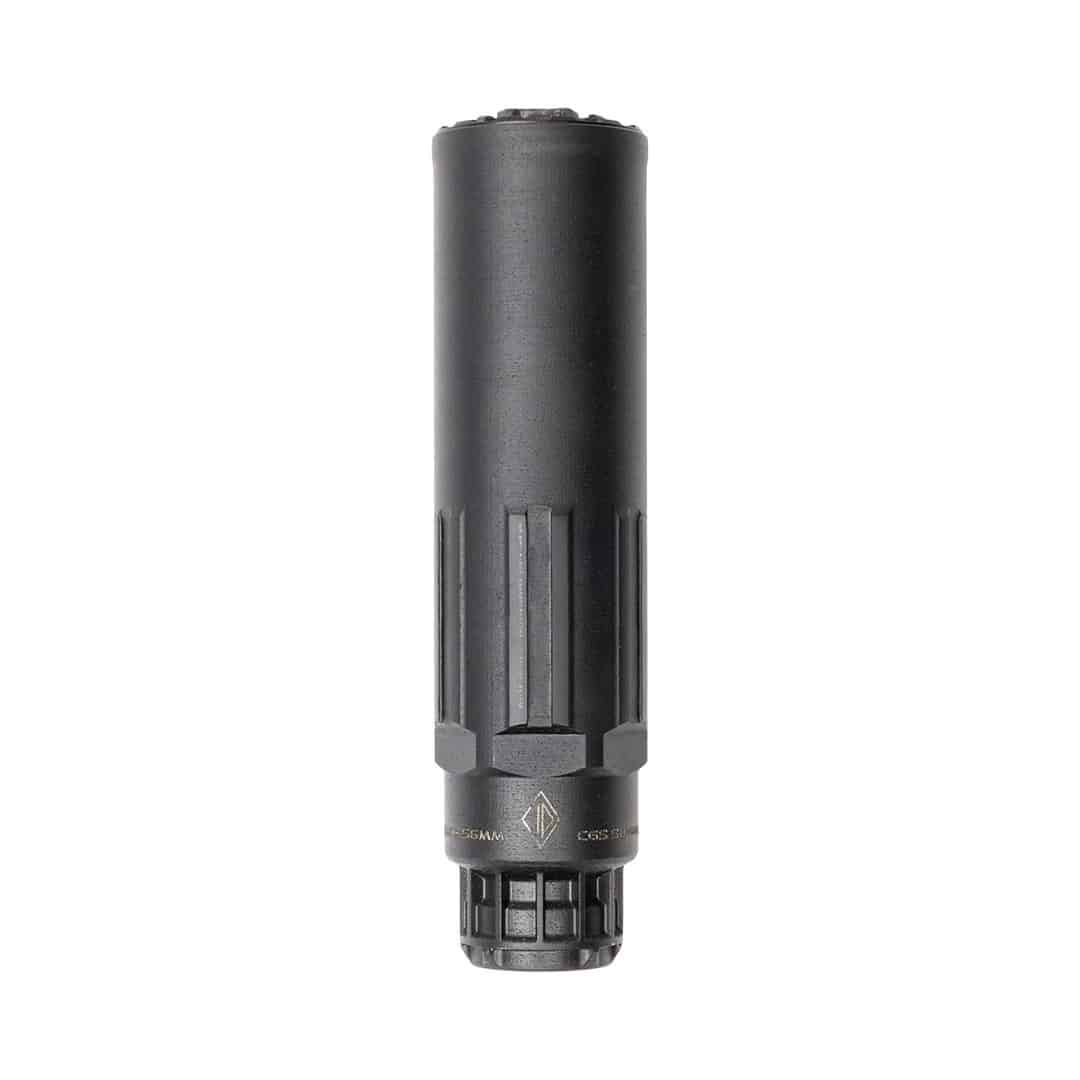
CGS Sci-Six
BattleHawk Armory (See Price)
Silencer Central (See Price)
Hinterland Outfitters (See Price)
The CGS SCI-SIX 5.56 is a compact, full-auto-rated suppressor built entirely from 718 Inconel using advanced 3D printing. It uses a proprietary taper-mounted flash hider (visible at bottom) with left-hand threads to stay securely attached under high rates of fire.
From the moment you pick it up, the CGS SCI-SIX exudes overbuilt quality designed for abuse. This dedicated 5.56 can was literally created with input from hardcore end-users (including special operations veterans) to thrive on an AR-15 in battlefield conditions.

What We Like: The construction is cutting-edge: a one-piece 718 Inconel body made via DMLS 3D-printing, with no welds or weak points, so it laughs off heat and full-auto punishment that might break lesser cans.
In fact, the SCI-SIX has no barrel length restrictions at all, meaning you can run it on short SBRs or dump mag after mag through it without worrying – a testament to its extreme durability.
Despite that bomb-proof build, it’s impressively compact and efficient. At about 6.5″ long (with its QD mount) and ~17 oz in weight, the SCI-SIX is similar in size to a SureFire SOCOM556-RC2, but with a larger diameter for more internal volume. That smart design pays off: the suppressor runs balanced, dramatically taming the 5.56’s bark and flash without choking your rifle in backpressure.

In testing, its sound reduction performance was right up there with the best, roughly on par with the SureFire RC2 and OSS Flow models, while edging out other respected heavy-duty cans. In real terms, shooting with the SCI-SIX is a much more pleasant experience: you immediately notice less gas blowing back in your face and smoother cycling, thanks to CGS’s variable-core baffle geometry that vents gases forward into an annular space instead of back into your action
The integrated flash-hider end cap and Inconel baffles also mean minimal muzzle flash.
All of this comes in a suppressor that stays mounted rock-solid via a tapered quick-attach muzzle device with left-hand threads, so recoil actually tightens it rather than working it loose.
In short, the SCI-SIX’s performance is remarkably well-rounded: it’s as quiet and recoil-smoothing as much larger suppressors, yet built to endure the kind of full-auto mag dumps and rough handling (drops, bumps, and heat) that would challenge any AR-15 suppressor.
Flaws but Not Dealbreakers: First is the price, at around $1,100-$1,200 street price (plus your $200 tax stamp if you SBR it), it’s a significant investment up front. That said, this pricing is in line with other top-tier full-auto cans, and considering the SCI-SIX includes its proprietary flash hider mount in the box, the value is reasonable for what you get.
Another consideration is that the SCI-SIX is dedicated to 5.56 NATO – it’s not a multi-caliber suppressor. If you were hoping to swap one can between your 5.56 AR and, say, a .30 caliber rifle, this isn’t the one to do it. The tighter bore and tailored baffle design give you superb performance on an AR-15, but you sacrifice versatility.

It is a bit heavier and bulkier in diameter than some lightweight or less robust options. At just over a pound, it’s no heavier than an RC2, but if you compare it to a compact titanium suppressor or an OSS Flow 556K, the SCI-SIX does add some weight out front.
Of course, those lighter options generally can’t survive the kind of abuse that this can shrugs off.
Lastly, you’ll need to use the CGS proprietary mounting system, which means sticking with CGS’s muzzle devices. The included flash hider mount is excellent – it’s repeatable, secure, and truly minimizes point-of-impact shift – but it isn’t cross-compatible with the more common mounts from SureFire, Dead Air, etc.
Bottom Line: The CGS SCI-SIX 5.56 is, in a word, a beast of a suppressor, and that’s exactly why it tops our list for full-auto-rated AR-15 cans. It was conceived from the ground up for the modern hard-use carbine: a suppressor that can run on a short-barreled M4 or MK18 all day long, kicking down doors, lighting up targets at night, getting banged around in vehicles or mud, and still keep running without a hiccup.
9. BEST .300 BLK/5.56 CROSSOVER SUPPRESSOR: Q Trash Panda
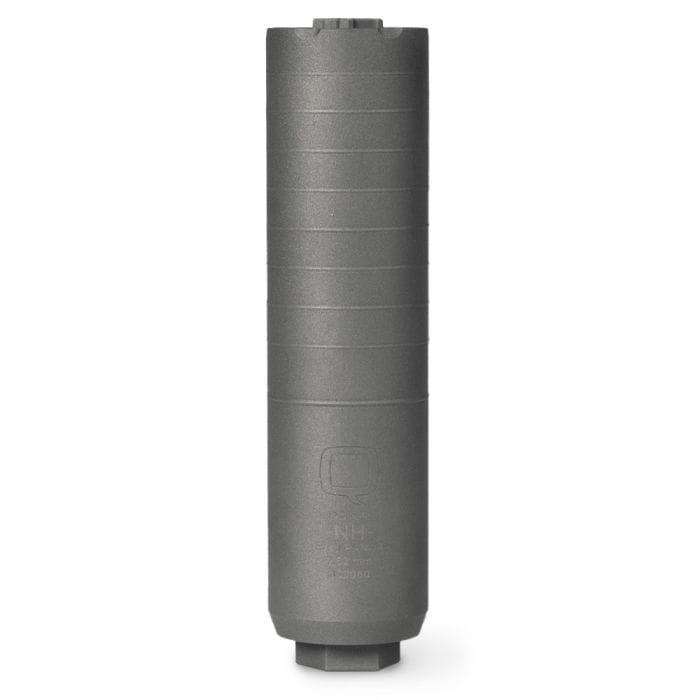
Q Trash Panda
KYGUNCO (See Price)
AR15 Discounts (See Price)
BattleHawk Armory (See Price)
Sportsman’s Outdoor Superstore (See Price)
The Q Trash Panda is a compact all-titanium .30-caliber suppressor engineered by the team behind the .300 AAC Blackout cartridge. In typical Q fashion (with tongue-in-cheek naming), it delivers serious performance in a surprisingly lightweight package. Weighing just 11.8 ounces and measuring 6.91 inches long, the Trash Panda adds minimal bulk to your rifle.
It’s rated up to .300 Win Mag, which speaks to its robust build, yet it truly shines on intermediate calibers. Designed originally with the .300 BLK in mind, it also works great on 5.56 rifles, making it a compelling crossover suppressor for AR-15 platforms.

What We Like: The Trash Panda hits the sweet spot for shooters who split range time between a .300 BLK SBR and a 5.56 upper. At just 6.9 inches long and a shade under a pound it barely changes rifle balance, yet it drags sub-sonic .300 BLK down to a low thump and trims 5.56 well into comfortable territory with basic ear protection.
Its 3-D-printed grade-5 titanium core keeps the baffles feather-light but strong enough for sustained mag-dump heat, while the tapered bore funnels gas forward so blow-back stays mild on short, over-gassed carbines.

Q ships two Cherry Bomb muzzle brakes in the box, one 1/2×28 and one 5/8×24, so moving the can between rifles takes a half-turn twist, no shims or Rocksett beyond the initial install. The taper-lock mount seats solidly every time, preserving zero when you swap from one gun to the next.
Because the Cherry Bomb sits in front of the blast chamber it absorbs the worst erosion; if it burns out you replace a seventy-five-dollar brake instead of the suppressor itself. No timing is needed, just torque it down and shoot.
Not surprisingly, given Q’s pedigree with .300 Blackout, the Trash Panda really shines with sub-sonic loads. The tone is a low, pleasing whoosh rather than the high-pitched crack shorter .30-cal cans can have, and even supersonic rounds lose their sharp edge.
All told, this little can offers a compelling blend of size, weight, versatility, and tone that’s hard to match if you split your time between .300 BLK and 5.56.
Flaws but Not Dealbreakers: When you slap the Trash Panda on a 5.56 AR (especially a short-barreled one), be prepared for some gas to the face. By nature of its baffle design and .30 caliber bore, this suppressor does introduce backpressure into semi-auto actions.
In rapid fire, you might catch whiffs of burnt powder and ammonia, and your rifle’s internals will get dirtier faster. This is a common trade-off with efficient baffle suppressors – they quiet the muzzle at the expense of more blowback. It’s not unique to the Trash Panda, but worth mentioning.

The Trash Panda does exhibit a pronounced first-round pop, particularly with subsonic ammo. That first shot out of a cold suppressor has extra oxygen to ignite, so it’s louder than subsequent shots.
The Trash Panda’s lightweight magic comes from its titanium construction, but Ti isn’t as bomb-proof under abuse as hardened steel or Stellite. For typical civilian use, titanium is plenty durable. However, if you plan on really pushing this can (back-to-back mag dumps, high round-count courses, or full-auto fire), be aware that titanium baffles will wear faster than steel baffles.
If you ever shoot your rifle unsuppressed with the Cherry Bomb brake, be ready for concussion and fireballs. This little muzzle device is basically a minimalist brake. It has no flash-hider prongs or diffuser, so it is obnoxiously loud, with a massive flash when fired on its own.
Bottom Line: The Q Trash Panda is tailor-made for shooters who want one suppressor to do it all on AR-style rifles. It hits a sweet spot for those running a .300 Blackout (or .308) and a 5.56 and looking for a single can to swap between them. If you primarily shoot subsonic .300 BLK, the Trash Panda is hard to beat, it delivers outstanding suppression (some would say stupid quiet performance) for that round.
10. BEST SUPPRESSOR FOR LONG-RANGE & HUNTING: Thunder Beast Ultra Series
Thunder Beast’s Ultra Series is legendary among precision shooters and back-country hunters for one simple reason: it delivers serious sound reduction without turning your rifle into a boat anchor.
Within the line, the Ultra 7 sits in the Goldilocks zone for long-range and field work-quiet enough to protect your ears for a handful of shots, yet short and light enough that you actually want to carry it all day.
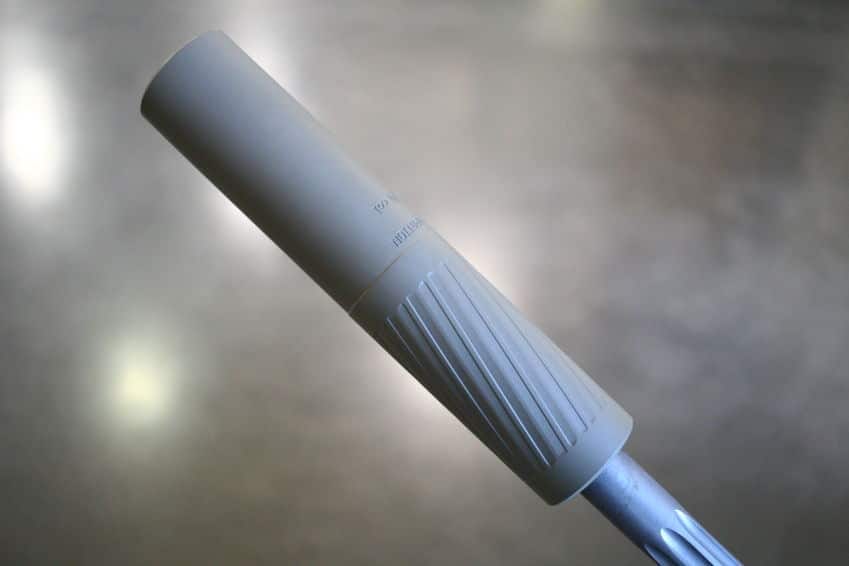
What We Like: The Ultra 7’s biggest selling point is how little it changes the way your rifle feels. Ten-ish ounces of all-titanium construction adds barely a half-pound to the muzzle, so you can climb ridgelines or work barricades without the nose-heaviness most “quiet” cans create. That low mass also means less harmonic whip when the shot breaks, which helps preserve the sub-MOA accuracy long-range shooters obsess over.
Sound suppression is excellent for the size. On a 6.5 CM bolt gun we meter average peaks around 132 dB, only a few decibels shy of much larger nine-inch cans and well inside hearing-safe territory for the handful of shots a hunter or PRS competitor typically fires. First-round pop is minimal, so the shot that matters most—the first—doesn’t blow your ears or spook game.
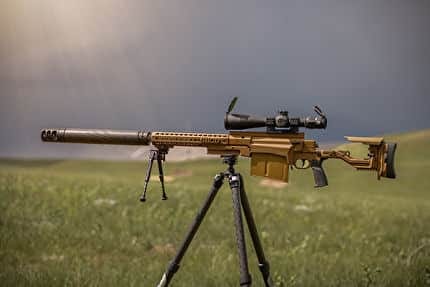
Point-of-impact shift is tiny and, more important, repeatable. Remove the can to clean the rifle, thread it back on, and your zero is still your zero—no frantic rezeroing the night before a match.
The CB (Compact Brake) mount uses a tapered shoulder that self-centers and locks up solid with just a quick twist, making caliber swaps or rifle changes painless without a toolbox.
Recoil and blast are noticeably tamed. You stay on target to spot your own hits, and the spotter beside you hears a dull thump instead of a bark-perfect for calling corrections. Internal volume is generous enough to handle magnum hunting rounds, yet back-pressure stays low on gas guns, so you’re not choking on blowback after a quick double-tap on a coyote.
Finally, Thunder Beast backs the Ultra series with a lifetime warranty and a reputation for no-questions support. If you manage to cook it red on a prairie-dog weekend, they’ll inspect, clean, and recore if needed for the cost of shipping.
Flaws but Not Dealbreakers: Hand-built titanium and a flawless Cerakote finish push street cost past a thousand dollars, which can feel steep when you could pick up a serviceable steel can for half that. If you shoot sparingly, the extra money may not pay visible dividends.
Heat management is another trade-off. The thin-wall titanium cools fast, but it also hits its red-line sooner than heavier Inconel cans. A pair of back-to-back five-round strings is fine; three mag dumps in a carbine class will edge past the recommended eight-hundred-degree ceiling and shorten service life.
The fix is simple: pace your fire or let it cool. But run-and-gun shooters should keep it in mind.
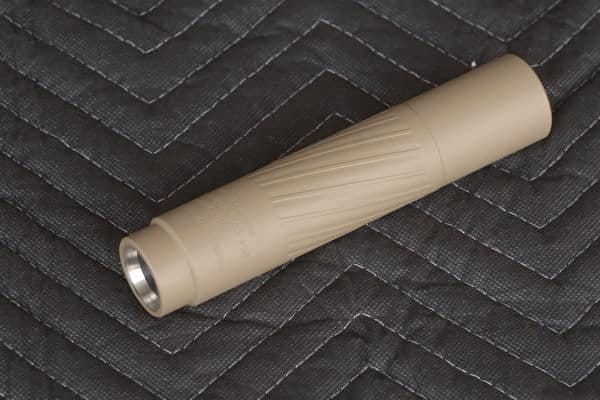
Mounting is direct-thread only. Thunder Beast’s Compact Brake adapter is quick and repeatable, yet switching the can between rifles still takes a wrench and a minute or two, unlike the one-hand twist of a QD collar. If you own a stable of ARs and bolts that share one suppressor, this adds a small layer of hassle.
Lastly, while back-pressure is modest, gas guns may need one click of gas adjustment or a tad more buffer weight to stay buttery smooth. It is a minor tune-up, but worth planning for if you expect drop-in perfection.
Bottom Line: The Ultra 7 is a purpose-built precision can for the hunter or long-range shooter who values first-shot reduction and repeatable point of impact over mag-dump durability. It costs more than a rugged Inconel tube and it asks you to pace your strings, yet it pays you back with best-in-class weight savings, class-leading sound numbers, and down-range consistency that keeps trophies on the pole and steel ringing.
11. BEST LIGHTWEIGHT 5.56 SUPPRESSOR: Banish 223
Stop in at any local gun shop and they likely have a Silencer Central kiosk for making suppressor buying super simple. They not only make the process easy, but also have a line of their own suppressors that are pretty impressive, all things considered.
The Banish 223 is a dedicated .223/5.56 suppressor aimed at AR-15 owners and varmint hunters who demand minimal weight on their barrel. This 100% titanium can measures 7 inches long and weighs just 11.4 ounces, making it one of the lightest options in its class. Despite the trim build, it’s rated for limited full-auto use and boasts a substantial 34 dB sound reduction, bringing a 5.56 rifle’s report closer to hearing-safe levels.

What We Like: At just 11.4 ounces, the Banish 223 is one of the lightest full-size suppressors in its class. That’s thanks to its all-titanium build, which manages to shed ounces without sacrificing durability. On a standard AR-15 with a 16-inch barrel, the balance feels right. There’s no nose-heavy swing or extra strain on the front end. It’s light enough that you don’t second-guess running it all day at the range.
We also like how quiet this can really is. Banish advertises up to a 34 dB sound reduction with the right ammo and barrel length, and it lives up to that. It’s one of the few 5.56 suppressors that we’d consider genuinely hearing safe, especially with ear pro.
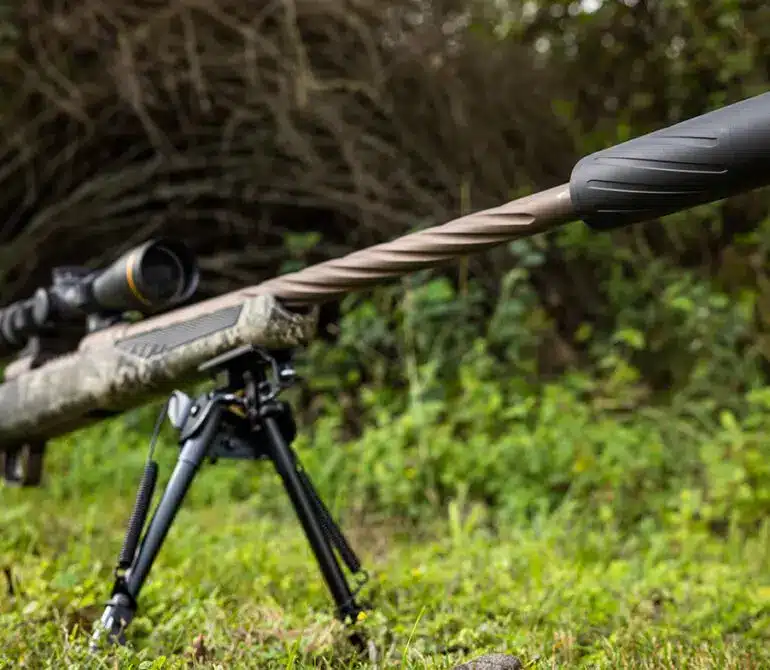
The simplicity of the design is another plus. This is a direct-thread suppressor that skips the complexity of quick-attach systems. That means fewer moving parts and fewer failure points over time. For shooters who just want something that works, it’s a great fit.
It also plays well with bolt guns. This suppressor threads on easily to most 1/2×28 muzzle threads, and its clean, quiet performance makes it just as valuable on a .223 varmint rifle as it is on an AR-15.
Flaws but Not Dealbreakers: You do give up some flexibility here. The Banish 223 is designed around .223/5.56-class cartridges and doesn’t support larger calibers. If you’re hoping to cover both your AR and a .308 bolt gun with a single suppressor, this isn’t the one to buy. For that kind of versatility, you’re better off with something like the Banish 30 V2.
This suppressor also doesn’t use a flow-through design, so you’ll get more backpressure than something like the HUXWRX Flow 556k. It’s not awful, but it’s noticeable, especially on gassier setups or shorter barrels. Gas to the face isn’t a dealbreaker, but it’s something to be aware of if you’re running an overgassed carbine.
Lastly, because it’s a direct-thread can, it takes a little longer to mount or remove than a QD suppressor. That might not matter if you’re just heading to the range, but if you’re swapping frequently between rifles, it’s a slower system.
Bottom Line: If weight is your top priority, the Banish 223 is our recommendation. It’s quiet, reliable, and remarkably light, making it ideal for shooters who want to keep their ARs trim and responsive. It won’t work across multiple calibers, and it’s not packed with fancy features, but for a dedicated 5.56 can that stays out of your way while doing its job well, this is a solid pick. Simple, quiet, and light. It’s just a good suppressor.
RECOMMENDED ACCESSORIES
Here’s a few things we’d recommend to pick up to pair with your new suppressor.

Burn Proof Gear Suppressor Cover
Adding a suppressor to your setup is a game changer, but it comes with a tradeoff: heat. After just a mag or two, that can turns into a branding iron. That’s why we like this suppressor cover from Burn Proof Gear.
It keeps the heat haze out of your optic, protects your gear (and your hands), and cuts down on that signature ping when your suppressor bumps against barricades. If you plan on training hard or running drills, this is one accessory you’ll be glad you added.

Cajun Patriots Suppressor Grease
Suppressor grease might not be the most exciting part of your setup, but it’ll be one of the most practical. It helps prevent carbon lock, making it much easier to remove your suppressor after extended shooting sessions.
It also protects the threads from wear and corrosion, ensuring a smooth install and removal every time. If you’re running a can regularly, a small amount of suppressor grease goes a long way in keeping your gear reliable and easy to maintain.
FINAL THOUGHTS ON BEST AR-15 SUPPRESSORS
There you have it, our top picks for the best AR-15 suppressors on the market today.
If you’re looking for the gold standard, the SureFire SOCOM RC2 is the one everyone else measures against. It’s battle-proven, brutally tough, and built to last.
Want one suppressor to cover your whole safe? The Banish 30 V2 gives you multi-caliber flexibility in a lightweight, modular package.
If you’re after a flow-through can that keeps gas out of your face, the HUXWRX Flow 556k and Anechoic AnechoX 30 both deliver a cleaner, more comfortable shooting experience, especially on short barrels.
Chasing the quietest option possible? The PTR Vent 3 is hard to beat for raw decibel reduction.
If you’re on a budget, the Otter Creek Polonium K gives you serious performance without draining your wallet. And for lightweight, dedicated 5.56 setups, the Banish 223 is a top-tier choice with almost no front-end drag.
Looking for the toughest full-auto rated can? The CGS SCI-SIX shrugs off abuse like it was built for war – because it kind of was.
Got your suppressor picked out? Don’t forget the essentials. A Burn Proof Gear Cover helps tame the heat, and a dab of Suppressor Grease keeps things running smooth.
What’s your go-to AR-15 suppressor? Also be sure to check out our article on the Best 9MM Suppressors. Got one you love that didn’t make the cut? Let us know in the comments.

Justin Trump is the managing editor and owner of CAT Outdoors. The son of a Vietnam veteran, he’s a Certified Glock Armorer, an avid gun enthusiast and 2A advocate. He holds two firearm patents for the CAT M4 and Talon tools. When not managing CAT Outdoors, he enjoys spending time with his family and friends, rooting for Michigan sports teams, and serving his church.

